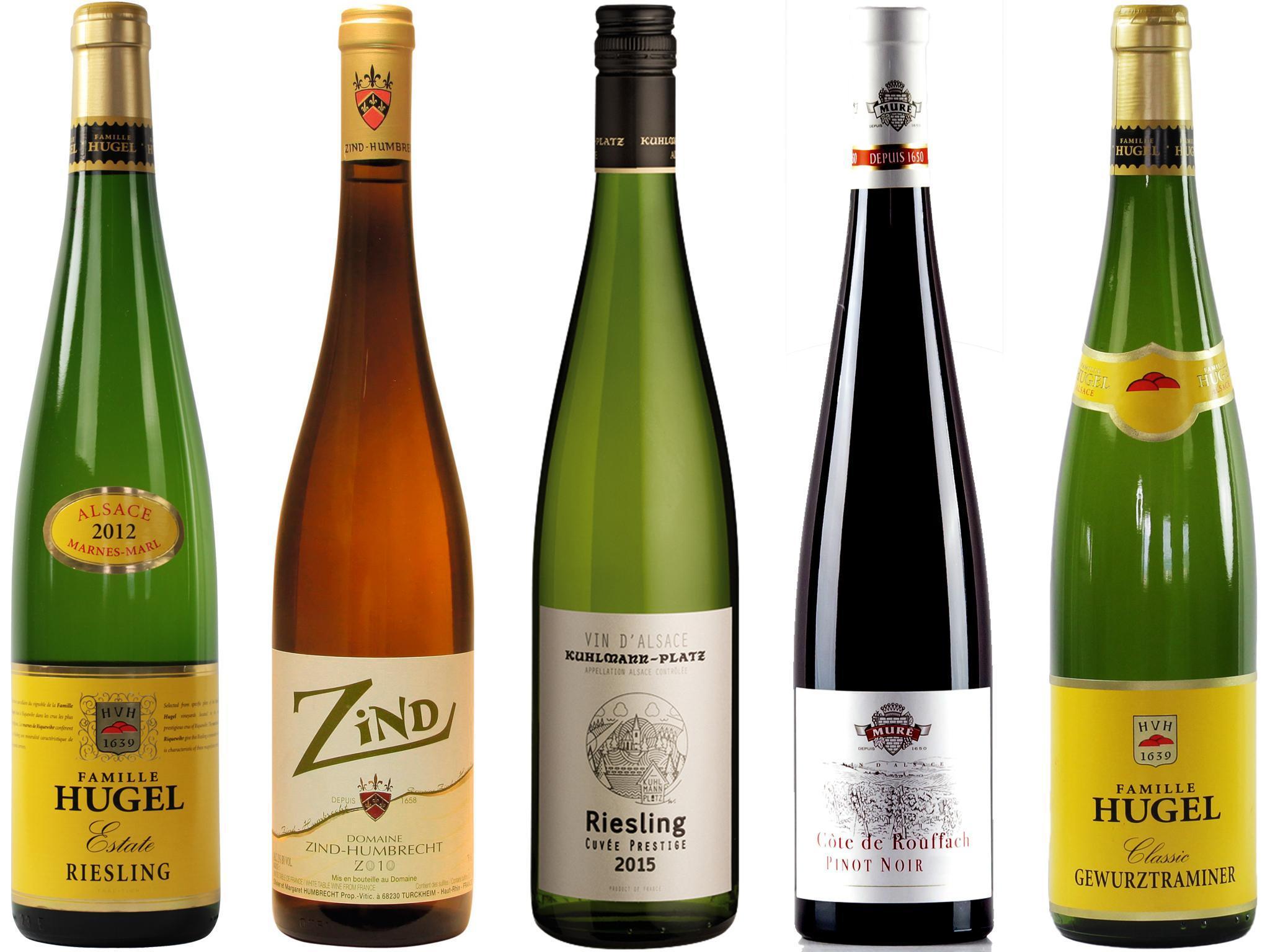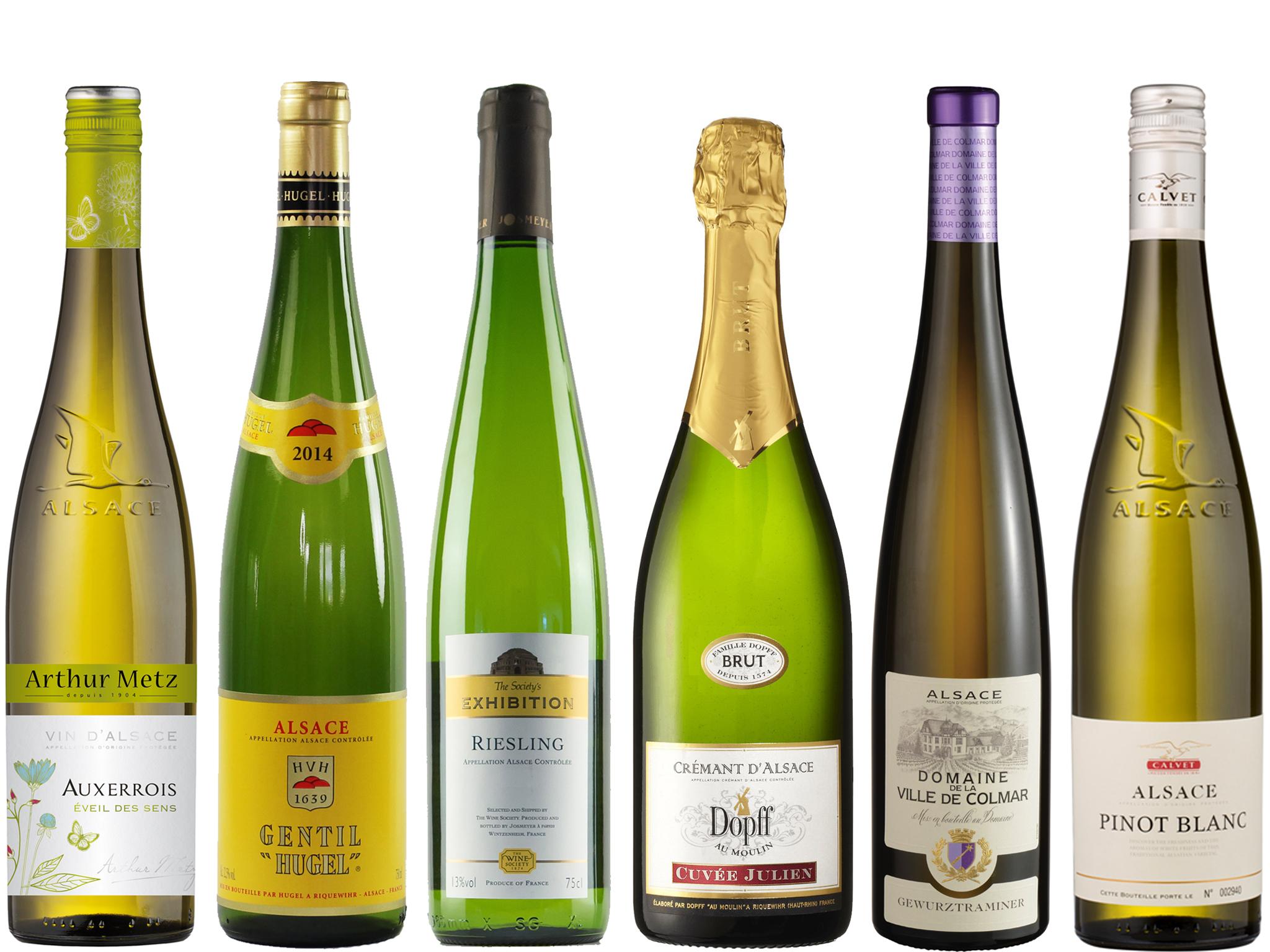The Independent's journalism is supported by our readers. When you purchase through links on our site, we may earn commission.
Wines of the week: 11 bottles from Alsace
The northeastern French region is somewhat cut off from the rest of the country and therefore produces distinctive, Germanic-leaning wines. Terry Kirby with riesling, gewurztraminer and more

After the wines of one vast country last week – Australia – today we turn to the wines of a small part of one much smaller country: the Alsace region of northeast France.
Almost cut off from the rest of France by the Vosges mountains to the west and bounded by the Rhine to the east, throughout history the region was fought over by France and Germany right up until the end of the Second World War. It retains a strong Germanic influence in its culture, the glorious architecture, its robust, meat-heavy foods and in its distinctive and individual wines. These light, fresh, unoaked, aromatic – sometimes intensely so – white wines benefit from a dry climate in the shadow of the Vosges, as well as a range of soil types on the lower slopes and the plain around the Rhine. They are dominated by two key grapes: the German influence is shown in the ubiquitous riesling grape which comes in a variety of styles and Alsace’s own slightly “love it or hate it” gewurztraminer. Although these grapes are grown in other parts of the world – as last week’s column demonstrated – you will struggle to find them or other local varieties such as auxerrois elsewhere in France.
This sense of slight geographical and cultural “apartness” means the wines of Alsace are distinctive and beguiling once you get to know them, but can also be a little confusing to newcomers, with Germanic names and script on these slightly odd tall, thin bottles – devised because they were the most efficient means of packing bottles for transport on Rhine barges – yet which come from France. Riesling can also be difficult to pin down as a grape – it can be sweet and luscious, off dry and light or, in some cases, confusingly aromatic, bone dry and almost savoury in its finish, much depending on the kind of soil on which the grapes are grown.
A good starting point for the grape is the Wine Society’s Exhibition Alsace Riesling 2016 (£14.50 thewinesociety.com), made for it by the highly regarded Josmeyer company just outside the pretty town of Colmar, in the hands of the same family since 1854 and now run by two sisters on biodynamic principles. Gorgeous floral aromas, a pure, ethereal touch on the palate with refreshing, lovely apple and peach flavours; ideal with shellfish.
Just a shade towards the off-dry spectrum is the Kuhlmann-Platz Riesling 2017 Cave de Hunawihr (£11.99, or £8.99 if bought as part of six bottle purchase, majestic,co.uk) with a lovely citrus freshness about it. Both wines are terrific spring wines, when it arrives.
For a real blockbuster riesling and something slightly more suited to cooler weather and the belt-bursting Alsatian cuisine of sausages, bacon and other pork cuts and choucroute – aka sauerkraut in Germany, variations of which appear on almost every restaurant menu – try the Hugel Estate Riesling (2012: £19.25 yorkshirevintners.co.uk; 2013: £25.90 hedonism.co.uk) from one of the biggest names in the area – less aromatic than the others, this has real depth and mouth-filling body, with pear and pie crust flavours and a long finish. And if you are not into choucroute, try this with a grilled prime fish, like a whole sea bass or John Dory.

So much for riesling; gewurztraminer is a more challenging grape, with a combination of exotic spices like ginger and cardamom, tropical and orchard fruits and intense, floral aromas. Hugel & Fils again delivers the powerful, structured benchmark version in the Hugel Classic Gewurztraminer (2014: £16.95 hailshamcellars.com; £20.50 etonvintners.com). This grape is one of the few positively recommended for Asian foods, such as spiced pork belly, although I don’t feel it makes a great companion for anything with too much chilli heat; far better as an unusual aperitif or with crustacea. Much less intense and wonderfully balanced between dryness, minerality and florality is the Domaine de La Ville de Colmar Gewurztraminer 2015 (£15.49 ocado.com), made by master winemaker Nicholas Haefflin and a lovely food wine – try with pasta with strongly flavoured sauces, particularly if featuring anchovies.
The auxerrois grape appears in both sparkling and still blends in the region, such as the organically grown, intense and vibrant Domaine Zind-Humbrecht Zind 2016 (£17.99 waitrosecellar.com), where it is blended with chardonnay in a wine that is simultaneously zesty, spicy and smoky; a real grown-up wine for serious shellfish. The same grape also works very well on its own in the Arthur Metz Auxerrois Spring Cuvee 2016 (£9.99 ocado.com) which is initially bright and light on the palate and gently floral on the nose, but gives way to some deeper spicy touches on the finish. Coincidentally, both Ocado and Asda currently also have on offer an excellent Alsace pinot blanc, the Calvet Alsace Pinot Blanc (£7.00, normally £7.98 asda.com; £8.39, normally £10.49 until 19 February 19; ocado.com), refreshing and bright, apple and citrus flavours, with a nice contrasting, creamy, smoky finish. Both excellent aperitif or seafood wines, or try them with Alsatian style onion tarts, which can be either thin, pizza style or thicker in the manner of quiche Lorraine, the neighbouring region.
If you are finding the thought of these different varieties a bit challenging, “gentil” is the local name for a blend of the so-called noble grapes of riesling, gewurztraminer, muscat and pinot gris, in varying proportions and sometimes accompanied by other grapes, including auxerrois, pinot blanc and sylvaner. So it’s back to Hugel & Fils for the Hugel Gentil 2016, (£13.30 tanners-wines.co.uk; £14.25 winedirect.co.uk) made from the noble quartet plus sylvaner, which combines the characters of all these grapes in an unusual and distinctive mix that is somehow uniquely Alsatian. A great “try to guess the grape” wine for your guests.
But it’s not just about these highly individual wines – Alsace also produces around half of all cremant, the sparkling wine made from the local grapes in a small number of regions around France: read my column from last year here for more about cremant and some great Alsatian recommendations. Another typical and terrific buy is the Cuvee Julian Dopff Au Moulin (£13.50 thewinesociety.com; £14.99 strictlywine.co.uk), a blend of auxerrois and pinot blanc and very typical of the refreshing and utterly irresistible cremant style; for celebrations and parties of all kinds.
Finally, after all those whiles, a red: 90 per cent of Alsatian still wine production is white and pinot noir is the only red grape that gets any attention and mostly reflects the German pinot style of lightness, minerality, spice, a touch of earth and very forward cherry fruit flavours. The elegant Cote de Rouffach Pinot Noir 2016 (£21.00 thewinesociety.com) is just about everything a gorgeous silky pinot should be, best served lightly chilled, with a plate of Alsatian charcuterie.
Join our commenting forum
Join thought-provoking conversations, follow other Independent readers and see their replies
Comments